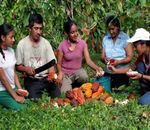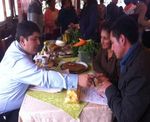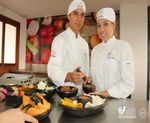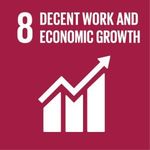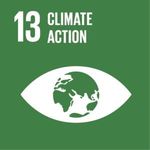Increasing the competitiveness of small producers and forest communities in Honduras
←
→
Page content transcription
If your browser does not render page correctly, please read the page content below
Supported by: Increasing the competitiveness of small producers and forest communities in Honduras Subcomponent: Increasing market opportunities for sustainable value chains in Honduras through the tourism sector Coordinator: Ana del Carmen Fortín, afortin@ra.org Implementing Organization: Rainforest Alliance, Honduras
Photographer: Charlie Watson
PRODUCTION AREAS: research. This approach has allowed the Rainforest Alliance to
expand the beneficiary regions in Honduras and to venture into
• Atlantic: municipalities of Esparta, Arizona, Tela, La Masi- various sectors.
ca, La Ceiba (Depts. Atlántida and Yoro).
This project aims to increase the competitiveness of forest
• Mosquitia: municipalities of Brus Laguna, Wampusirpe communities and small producers of cocoa, coffee, rambutan,
and Puerto Lempira (Dept. of Gracias a Dios), Iriona (Dept. and timber products; it contributes directly to the national-lev-
of Colón), Culmí and Catacamas (Dept. of Olancho). el efforts aimed at achieving the Sustainable Development
Goals (SDGs), particularly those related to the national frame-
• Central-East: Guaimaca, Talanga and Campamento work and strategy to advance SDG-11: Responsible Produc-
(Depts. Francisco Morazán y Olancho). tion and Consumption. To achieve the goals of the project, the
components mentioned below are implemented.
• Dry Corridor: in the Dept. of Copán and Lempira.
Within the market access component, a subcomponent has
BACKGROUND ON THE RAINFOREST ALLIANCE’S been included, whose objective is to increase market opportu-
WORK: nities for sustainable value chains through the tourism sector.
This subcomponent supports the project to achieve the objec-
For more than 30 years, the organization has worked to con- tives related to the increase of sales, the development of new
serve biodiversity and ensure sustainable livelihoods through products, the creation of employment, market alliances, and
the transformation of land use practices, business practices, the participation of women in the value chains of cocoa, coffee,
and consumer behavior. rambutan, and wood, through the participation of the tourism
sector as an engine of conservation and generation of sustain-
In the Mesoamerican region, the Rainforest Alliance develops able livelihoods in rural landscapes.
projects that promote the production and sale of sustainable
products from the forest and agricultural activities, integrating
men and women into productive activities for the generation Project Goals
of economic, social, and environmental benefits. Its main ob-
jective is to increase the competitiveness, sustainability, and • 30 forest SMEs strengthened.
access to markets of agricultural and forestry operations, and
through the principle of “learning by doing,” the beneficiaries of • 2,700 families improve their income.
these projects have an active participation in new investments
and trade for the region. • 300 new jobs created.
In Honduras, the Rainforest Alliance has been providing tech- • 100,000 hectares of preserved tropical forest.
nical assistance since 2005 to rural communities linked to the
protection and sustainable use of the forest, especially in the • 10,000,000 tons of carbon captured on the ground.
region of the Rio Plátano Biosphere Reserve (RPBR). Initia-
tives have also been strengthened with non-timber products, • Increase in total sales of timber products to US
like xate, masica, and cocoa. In June 2015, the organization $800,000.
expanded its sectoral approach towards one based on the
conservation and improvement of livelihoods in productive • Increase in total sales of cocoa, coffee, and rambutan
landscapes, thus opening the range of opportunities to support to US $1,500,000.
different value chains in agriculture, forestry, and tourism and
to cover cross-cutting issues such as climate, education, and
2Component 1. Organization and preparation of SMEs operated by communities and small producers. It is precisely
within this component that a subcomponent of alliances with
It is aimed at identifying and preparing micro, small and me- the tourism sector is inserted to enhance sustainable supply
dium-sized enterprises (SMEs), producers of cocoa, coffee, commitments (green purchases) that allow Honduran tourism
rambutan, and forest products to connect them with financing companies to advance their own sustainability efforts.
sources and break barriers to access them. It starts with the
base information of each SME (diagnoses, baselines, and im-
provement plans) and then investment plans, business plans, We believe in the potential of the tourism sector as an
and administrative and financial controls are elaborated, and engine for the conservation and generation of sustain-
credit management units are created to ensure the successful able livelihoods in rural landscapes.
performance of the financing facilitated by the project.
Goal: At least 30 tourism companies strengthened in
Component 2. Technical assistance for SMEs sustainable procurement and establishing preferential
purchasing commitments with sustainable producers of
The Rainforest Alliance, together with local partners such as cocoa, coffee, rambutan, and timber products.
the Institute for Cooperation and Self-Development (ICADE),
implements technical assistance for companies producing co-
coa, coffee, rambutan, and forest products. The main areas of Component 3. Access to financing
focus are: (i) organizational and business strengthening to en-
hance the capacities of leaders and partners, and the strength- Executed by the Honduran microfinance lender Family and En-
ening of administrative and financial management; (ii) improve- vironment (FAMA-OPDF), based on a fund co-created with the
ment of the value chain in aspects of production and logistics Multilateral Investment Fund (MIF), for the placement of loans
infrastructure, design of products and services, implementa- to beneficiaries of the four value chains. It includes activities to
tion of good practices, primary and secondary value-added design financial services tailored to the needs of these benefi-
processes, as well as the construction of strategic alliances and ciaries and to train loan officers.
productive linkages; (iii) access to markets through long-term
strategic alliances with national and international buyers inter- Component 4. Alignment for scalability
ested in participating in the consolidation of value chains and
investing in the organization of a supply of legal and sustain- It seeks to strengthen the efforts of the Honduran government
able sources. The Rainforest Alliance has a network of respon- to attract climate funds to the country, such as an investment
sible buyers in the regional and international market, both in plan for the Forest Investment Program (FIP) and proposals for
the agroforestry and forestry sectors, committed to sourcing the Green Climate Fund.
from sustainable sources and supporting social enterprises
Workers in Honduras separating ripe coffee cherries. Photographer: David Dudenhoefer
3SUBCOMPONENT OF LINKAGE WITH THE TOURISM SECTOR — THEORY OF CHANGE AND CONTRIBUTION TO THE
GOALS OF THE PROJECT AND THE SDGS:
Impacts
Jobs
Identification of current
Inventory of current Mapping key supply needs and
suppliers by category destinations in practices in the chosen
for each value chain. Honduras that have the destinations and
potential to become distributors /
local markets. intermediaries.
Sales
Women’s
Selection of producers participation
and strengthening of Identification of training
business capacities. needs in participating Implementing marketing
tourism businesses on best activities and tradeshows.
practices for sustainable
procurement policies.
Carbon
sequestration
Innovation
STRATEGIC PARTNERS: BENEFICIARIES:
The Rainforest Alliance works with public and private sector 30 micro-, small and medium-sized enterprises producing ca-
partners such as ICADE, FAMA-OPDF, the Valle de Lean Busi- cao, coffee, rambutan, and wood that bring together 2,706
ness Development Center for SMEs, the Forest Conservation families, with the participation of about 1,995 men and 711
Institute, the Cocoa Producers Association of Honduras, the women, including indigenous communities. Strengthening
Secretariat of Natural Resources and Environment (MiAm- sustainable procurement commitments in at least 30 tourism
biente), and the Canada-Honduras Project on Agroforestry companies committed to rural development, as well as local
Value Chains. For the subcomponent of linkage with the tour- institutions working on sustainable production and consump-
ism sector, the Rainforest Alliance has the local support of the tion in the tourism sector. In addition, three leading territori-
Destination Management Organization Atlántida, the National al councils of productive undertakings will be accompanied in
Chamber of Tourism of Honduras—La Ceiba and other subsid- their processes of governance, management, and conduction
iaries—and the Association Pro Tourist Communities of Hondu- of their timber and agricultural production entities.
ras. In addition, it supports the efforts of the Honduran Institute
of Tourism (IHT), MiAmbiente, and the National Council for TIMEFRAME:
Sustainable Development, regarding sustainable production
and consumption in the tourism sector. This subcomponent is November 2017 - October 2020
supported by the Charles R. O’Malley Charitable Lead Trust.
4You can also read





